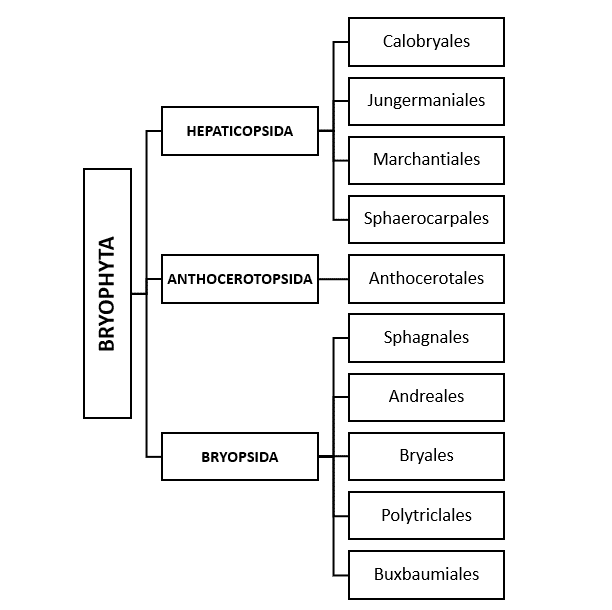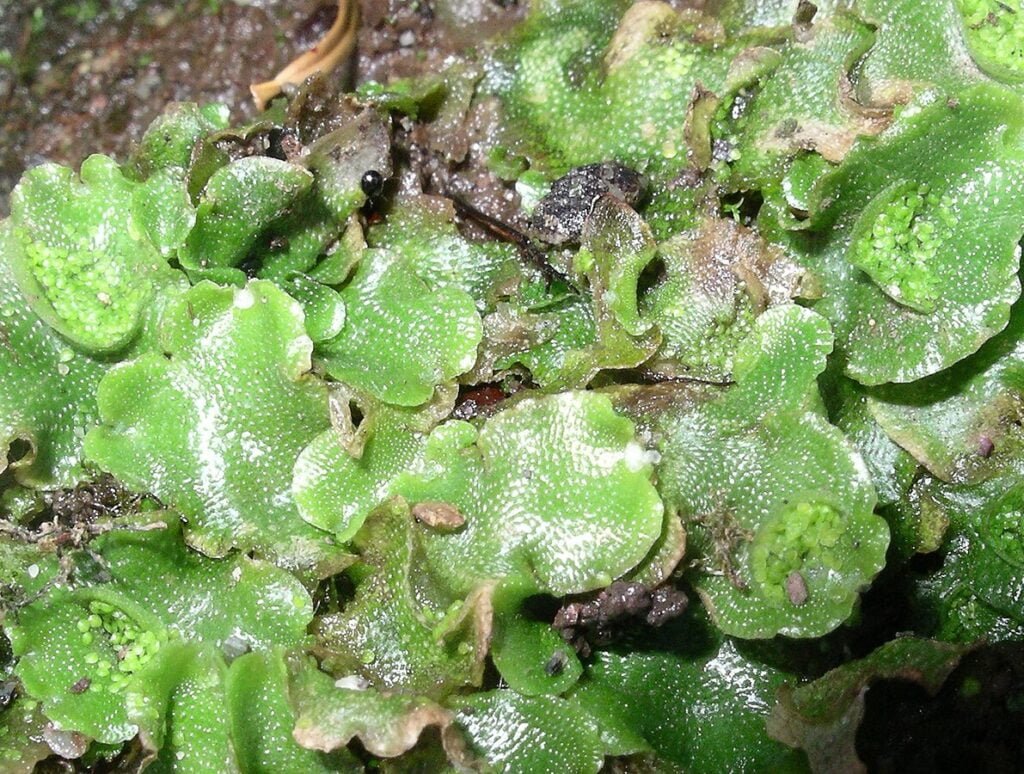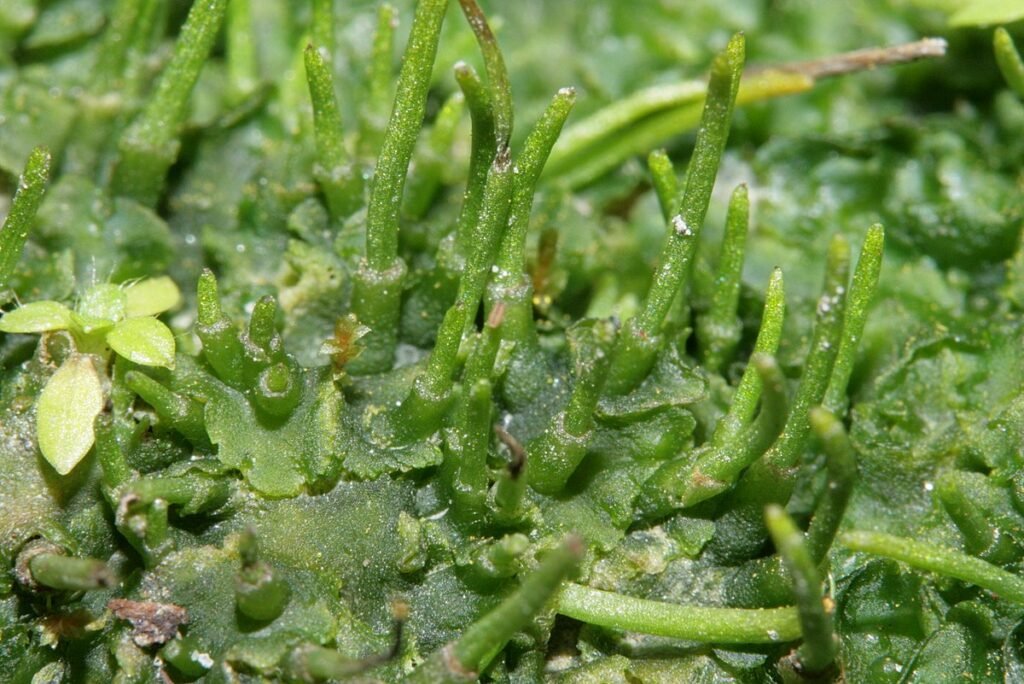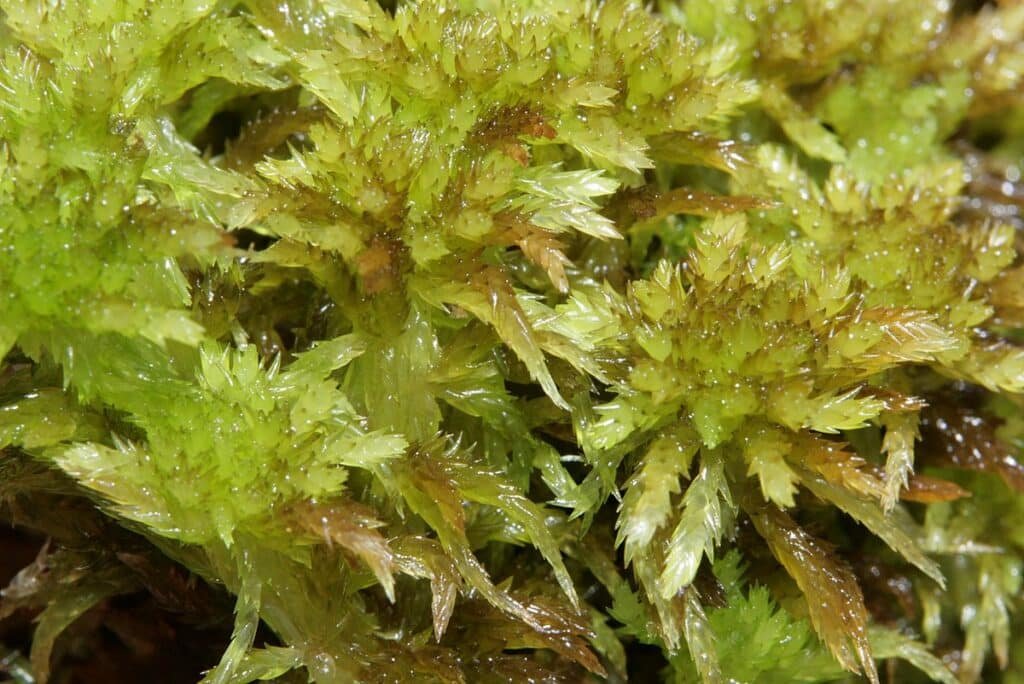Based on various important characteristics, Bryophyta is classified into three different classes viz, Hepaticopsida, Anthocerotopsida and Bryopsida commonly referred to as Liverwort, Hornwort and Moss respectively.
Some of the important characteristics taken into consideration for the classification of bryophytes are as follows;
- External and internal structure of the thallus.
- Types of rhizoids.
- Types of scales.
- Position of sex organs.
- Structure and nature of sporophyte.
- Degree of sterilization in the sporophyte.
Classification of Bryophyta
The term Bryophyta was first coined by Braun in 1864, although he included algae, fungi, lichens, and mosses within the group. Later, algae, fungi, and lichens were placed in a separate division called Thallophyta, while liverworts and mosses remained in the division Bryophyta.
In 1956, the International Code of Botanical Nomenclature (ICBN) recommended that the suffix-opsida be used for class names, a suggestion that had already been proposed by Rothmaler in 1951 for the classes of Bryophyta. He changed the class names as;
- Class I. Hapaticae as Hepaticopsida.
- Class II. Anthocerotae as Anthoceropsida
- Class III. Musci as Bryopsida.
Proskauer (1957) suggested that the class name Antheoceropsida should be Anthocerotopsida. Parihar (1965) and Holmes (1986) followed Proskauer’s classification and divided Bryophyta into three classes;
- Class I. Hepaticopsida
- Class II. Anthocerotopsida
- Class III. Bryopsida

General Characteristics
Class I. Hepaticopsida
- This class comprises around 280 genera and 9,500 species.
- Hepaticopsida is from the Latin word “Hepatica,” meaning liver, hence commonly known as liverworts.
- The plant body is gametophytic, with the gametophyte being either thalloid or foliose.
- Thalloid forms are prostrate, lobed, dorsiventral, and dichotomously branched. In foliose forms, the ‘leaves’ are entire, lobed, or divided and lack a ‘midrib’.
- ‘Leaves’ are arranged in two to three rows on the axis.
- Rhizoids are unicellular and branched.
- Photosynthetic cells contain numerous chloroplasts but no pyrenoids.
- Sex organs are borne dorsally or apically, either superficially or embedded in gametophytic tissue.
- Members can be monoecious or dioecious.
- The sporophyte can be simple and represented only by a capsule (e.g., Riccia) or differentiated into foot, seta, and capsule (e.g., Marchantia).
- The archesporium originates from the endothecium.
- Sporogenous tissue may either produce only spores (e.g., Riccia) or differentiate into sterile elater mother cells and fertile spore mother cells.
- The capsule lacks a columella.
- Elaters are unicellular, hygroscopic, and have spiral thickenings.
- The capsule wall is one to several layers thick and lacks stomata.
- Capsule dehiscence is irregular or occurs in a definite number of valves.
- Upon germination, spores form the gametophytic plant body. These plants exhibit heteromorphic alternation of generations.

Class II. Anthocerotopsida
- This class includes about 6 genera and 300 species.
- The plant body is flat, dorsiventral, thalloid, gametophytic, and variously lobed.
- Smooth-walled rhizoids are present but tuberculated rhizoids and scales are absent.
- The thallus is internally undifferentiated into different zones.
- Air chambers or air pores are absent.
- Each cell contains a single chloroplast, with each chloroplast having one to many pyrenoids.
- Mucilage cavities open on the ventral surface through slime pores.
- Sex organs are embedded in the thallus.
- Antheridia develop singly or in groups within closed cavities called antheridial chambers.
- The sporophyte is differentiated into foot, an intermediate or meristematic zone, and capsule.
- The presence of the meristematic zone allows the sporophyte to exhibit indeterminate growth, meaning it can grow indefinitely.
- The archesporium originates from the amphithecium.
- Sporogenous tissue produces fertile spores and sterile elaters.
- Elaters lack spiral thickenings and are known as pseudo elaters.
- The capsule wall is four to six layers thick, with the epidermis containing stomata.
- The capsule matures from apex to base and typically dehisces by two valves.

Class III. Bryopsida
- This is the largest class in Bryophyta, comprising about 700 genera and 14,000 species.
- The main plant body is gametophytic, divided into two stages: juvenile stage and leafy stage, or gametophore.
- The germination of the spore develops green, filamentous, branched structures called protonema, represents juvenile stage.
- Gametophores are erect leafy branches that develop on the protonema.
- Gametophores can be branched or unbranched and are differentiated into three parts: rhizoids, ‘stem,’ and ‘leaves.’
- Branches arise below the ‘leaves.’ ‘Leaves’ have a midrib, are unlobed, and are arranged spirally in three to eight rows on the axis.
- Rhizoids are multicellular, filamentous, branched with oblique septa.
- The axis consist of cortex enclosing central conducting strand.
- Superficial cells of gametophores give raise antheridia and archegonia.
- The sporophyte is green in the early stages and can be differentiated into foot, seta, and capsule.
- The seta is usually elongated and rigid.
- The capsule wall is interrupted by stomata in several places.
- Columella is endothecial in origin and is usually present.
- The archesporium develops into spores but elaters are absent.
- Capsule dehiscence occurs by the separation of a lid or operculum.
- The peristome aids in the dispersal of spores.
- Upon germination, spores produce protonema.

Affinities of Bryophyta to Algae and Pteridophyta
From evolutionary point of view Bryophyta occupy an intermediate position between the Algae and the Pteridophytes. They show affinities with both Algae and Pteridophytes.
Similarities Between Bryophytes and Algae:
- The plant body is simple, thalloid, and gametophytic.
- They are autotrophic.
- The gametophytic phase is dominant.
- They lack roots.
- Their cell walls are composed of cellulose.
- They have similar pigments in their chloroplasts, including chlorophyll a, chlorophyll b, α and β carotene, lutein, violaxanthin, and zeaxanthin.
- Vascular tissue is absent.
- Antherozoids are motile and bi-flagellated.
- The flagella are of the whiplash type.
- Water is essential for fertilization.
- Bryophytes produce a filamentous protonema (juvenile stage in mosses) that resembles filamentous green algae.
- In the order Anthocerotales of Bryophytes, plastids contain a pyrenoid, a feature characteristic of Chlorophyceae (green algae).
Similarities Between Bryophytes and Pteridophytes:
- Both are terrestrial plants.
- The primitive, simple, leafless, and rootless sporophytes of Pteridophytes (order Psilophytales) can be compared with the sporophytes of Bryophytes.
- Sexual reproduction is oogamous.
- Androcytes are surrounded by a sterile jacket layer.
- Antherozoids are flagellated.
- Water is essential for fertilization.
- The zygote is permanently retained within the archegonium.
- The zygote develops into an embryo.
- The moss capsule is similar to the terminal sporangium and columella of Psilophytales.
- Both Bryophytes and Pteridophytes exhibit heteromorphic alternation of generations.



Pingback: Bryophytes; Characteristics and Their Origin - BioQuestOnline